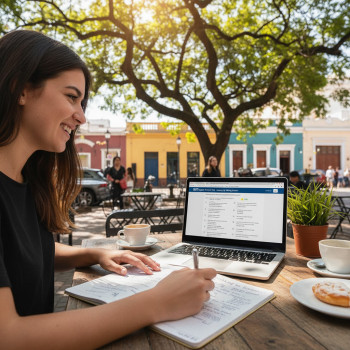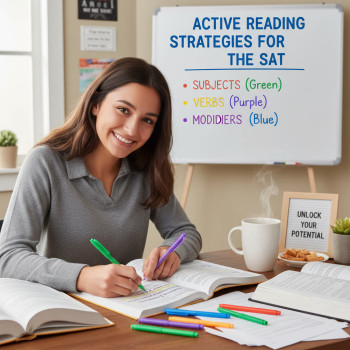Why Independent Problem-Solving Matters for the Digital SAT
Preparing for the Digital SAT is about more than memorizing formulas or pruning vocabulary lists. It’s a chance for students to learn how to think independently under pressure: to analyze unfamiliar problems, choose smart approaches, and recover gracefully when an answer doesn’t come quickly. Independent problem-solving is a muscle. The more you use it in realistic ways, the stronger it gets — and that strength shows up on test day, in classroom work, and in college and career life beyond scores.

What “Independent Problem-Solving” Really Looks Like
It’s easy to say “be independent,” but what does that mean practically during SAT prep? Think of it as a set of observable skills and habits that students can practice:
- Recognizing what kind of problem you’re facing (conceptual, calculation, interpretation).
- Choosing an approach quickly — diagram, plug-in numbers, eliminate answers, or reason verbally.
- Monitoring progress: checking if your method is working and knowing when to shift strategy.
- Learning from mistakes: turning a wrong answer into a pathway for improvement.
- Managing time and emotional energy when a problem stalls you.
Why this is especially important for the Digital SAT
The Digital SAT’s layout, built-in tools, and shorter adaptive modules reward strategic thinking more than raw endurance. Because the test adapts and gives a different mix of questions, your ability to analyze and pivot in real time is a core advantage. Independent problem-solvers can make better choices about when to spend time, when to use a test tool, and when to move on.
Getting Started: A Growth-Minded Approach
The first step is mindset. Students who treat ability as something that grows with effort — a growth mindset — are more willing to experiment with strategies and persevere after setbacks. Parents can help by praising process over innate talent: celebrate persistence, thoughtful guesses, and careful checking rather than labeling a student as “smart” or “not a math person.”
Quick habits that build a growth mindset
- Daily reflection: write one small thing you tried that was new and what you learned.
- Normalize struggle: share a story of a time you learned through mistakes.
- Set process goals, not just outcome goals — e.g., “I’ll try two new solution strategies this week,” instead of only targeting a score.
A Practical Framework for Independent Practice
Independent problem-solving isn’t accidental. It grows from structured, purposeful practice. Use this simple but powerful framework: Observe → Try → Check → Reflect → Adjust. Repeat.
1. Observe the problem
Before writing anything, take 10–20 seconds to read and think. Ask: what is this asking? What information is given? What tools might help (diagramming, table, plugging in numbers, process of elimination)?
2. Try with intention
Pick one strategy and commit to it for a set time (e.g., two minutes). This avoids the paralysis of switching methods too often and lets you test if a strategy will work.
3. Check efficiently
After your attempt, step back and ask: Is this working? If yes, continue; if no, identify one reason why and switch strategies. Track the thought: was the setup wrong, a calculation error, or a misread of the question?
4. Reflect and adjust
When practice is over, note what went well, what failed, and what you’ll try next time. Reflection is the bridge between mistakes and learning.
Study Techniques That Encourage Independence
Here are concrete study methods that push students to think for themselves, not just repeat patterns.
1. The 3-Question Challenge
Pick three problems slightly above current comfort level. Spend focused time on each using the Observe→Try→Check→Reflect cycle. Do this twice weekly. Over time, this raises the threshold of what feels solvable.
2. Teach-Back Sessions
Explain a solved problem to a peer, sibling, or parent without notes. Teaching forces you to organize reasoning and spot gaps. Parents: resist the urge to jump in. Ask probing questions instead of giving the answer.
3. Time-Boxed Exploration
Allow short, timed exploratory sessions where the aim is to try unusual strategies (reverse-engineer multiple choice answers, make a quick sketch, or create a table). Time-boxing reduces anxiety about wasting time.
4. Error Journals
Keep a dedicated notebook (or digital doc) where each mistake is recorded with three elements: what went wrong, why it happened, and one action to prevent it. Review this weekly to see patterns and celebrate progress.
Tools and Routines That Support Problem-Solving
Tools should help thinking, not replace it. Use these routines to scaffold independent learning while gradually reducing support.
- Scaffolded Practice: Start with guided practice (scaffolded hints), then move to untimed, unaided attempts.
- Chunking: Break long practice into 20–40 minute focused blocks followed by short breaks.
- Use built-in test tools in practice: When practicing digitally, mimic the test environment — use the calculator and answer-elimination tools as intended so decisions become automatic on test day.
- One-Question Deep Dives: Occasionally spend an entire session unpacking one rich question — variations, traps, and alternate approaches.
Example Routines: A Weekly Plan for Building Independence
This sample plan balances skill work, strategy practice, and reflection. It’s adaptable to different schedules.
| Day | Activity | Purpose | Time |
|---|---|---|---|
| Monday | Targeted skill practice (algebra/vocab) | Build content knowledge | 40 minutes |
| Tuesday | 3-Question Challenge + short reflection | Stretch problem-solving | 60 minutes |
| Wednesday | Teach-back to parent/peer | Explain reasoning out loud | 30 minutes |
| Thursday | Timed section practice (digital simulation) | Time management & strategy | 50–80 minutes |
| Friday | Error journal review + skill mini-drill | Fix recurring errors | 30 minutes |
| Weekend | Full practice test or mixed practice | Endurance and performance check | 3–4 hours (or split sessions) |
How Parents Can Encourage, Without Taking Over
Parents play a crucial role — not as answer-providers, but as coaches of the process. Here’s how to strike the balance.
Do
- Ask open-ended questions: “How did you decide to start that way?” or “What’s another way to try it?”
- Provide structure: help create study schedules and quiet workspaces.
- Model calm under stress: show how to take a break or reframe a setback.
- Celebrate process: praise persistence and strategy over right answers alone.
Don’t
- Fix every mistake immediately or jump in with the answer.
- Measure progress only by practice test scores; track small wins too.
- Turn practice into punishment. Keep it purposeful and balanced.
Designing Practice That Mirrors Real-World Problem-Solving
One of the best ways to build independence is to practice in contexts that feel authentic. Here are ideas to make practice richer and more transferable.
1. Contextual Problems
Convert abstract questions into real-life scenarios: budgeting for college, interpreting a graph in a news story, or explaining a passage’s argument to a friend. This promotes interpretation, synthesis, and clarity of thought.
2. Open-Ended Variations
Once a student has solved a problem, change one element (numbers, assumptions, or constraints) and solve again. This strengthens transferable reasoning rather than rote pattern recognition.
3. Low-Stakes Public Problem Solving
Encourage students to solve something aloud in a club, classroom, or study group. Verbalizing thought processes builds clarity, confidence, and the habit of checking assumptions.
Measuring Progress: Smart Metrics, Not Just Scores
While practice test scores matter, they don’t tell the whole story. Combine scores with qualitative metrics to track real independence.
- Average time spent before switching strategies on hard problems.
- Number of times a student uses a new strategy successfully.
- Reduction in recurring error types logged in the error journal.
- Self-reported confidence when approaching unfamiliar questions (scale 1–5).
Using Technology and Tutoring to Boost Independent Thinking
Technology and tutoring should empower students, not create dependence. The right tools can accelerate learning by providing transparent feedback and tailored practice.
Smart use of digital resources
Use official practice platforms and digital simulations to familiarize students with the test’s functionality and timing. Encourage students to practice using the same tools they’ll have on test day, then gradually remove supports (e.g., calculator use for certain items) to build raw reasoning skills.
When tutoring helps
Tutors can model thinking, provide targeted feedback, and set challenges that stretch a student’s independent problem-solving. If you choose a tutor, look for someone who emphasizes strategy and thinking processes rather than quick tips and answer memorization. Tutors who craft tailored study plans and provide 1-on-1 guidance — for example, personalized pacing, strategy tweaks, and feedback loops — can be especially effective.
For families exploring guided help, Sparkl’s personalized tutoring offers 1-on-1 guidance, tailored study plans, expert tutors, and AI-driven insights that can highlight recurring error patterns and suggest targeted practice. When used as a coach rather than a crutch, such services can speed progress while keeping independent problem-solving front and center.
Common Roadblocks and How to Overcome Them
Along the way, students often get stuck — and that’s normal. Anticipating common roadblocks makes them easier to navigate.
Roadblock: Fear of being wrong
Fix: Reframe mistakes as data. Create a ritual: every wrong answer must be logged with one concrete lesson learned.
Roadblock: Jumping to a favorite strategy
Fix: Encourage a two-step rule: always spend 15–20 seconds thinking of at least two possible approaches before committing to one.
Roadblock: Over-reliance on hints or tutors
Fix: Build fading supports — require one independent attempt before asking for help. Tutors and parents should follow an ask-model: ask questions that lead the student to the solution rather than giving it away.
Test-Day Mindset and Routines
Independent problem-solving shines on test day when it’s been practiced. Simple rituals help preserve mental energy.
- Sleep and nutrition: aim for consistent sleep the week before, and a balanced meal before the test.
- Warm-up: do two or three short, non-stressful problems to get into “thinking mode.”
- Flexible timing plan: know when to linger and when to move on — have a pre-decided threshold for when to skip and flag a question.
- Recovery plan: if a section goes poorly, allow a brief regroup (deep breaths, drink water) and reset mentally for the next section.
Real-World Success Stories (Mini Case Studies)
Here are short, anonymized examples that show how independent problem-solving unfolds over time.
- Case A — Priya: Struggled with data interpretation. Her tutor introduced the 3-Question Challenge and an error journal. Within six weeks, she reduced careless graph-reading errors by 70% and became the class student who peers asked to explain data questions.
- Case B — Miguel: Loved algebra tricks but froze on novel questions. He practiced teach-back sessions and timed exploratory blocks. His confidence rose; he started identifying when tricks wouldn’t work and switched to conceptual setups faster on test day.
- Case C — Sam: Was anxious about time. Sam’s parent helped design a timing plan that prioritized early wins. He learned to flag and return to problems, which increased his section score and lowered test anxiety.
Closing: A Partnership for Growth
Independent problem-solving on the SAT is not a solitary sprint — it’s a training program that benefits from intelligent support. Students become self-reliant when they practice with intention, reflect honestly, and receive guidance that nudges rather than does. Parents are most helpful when they structure opportunities, encourage process, and resist rescuing.
If you’re considering structured support, look for tutoring and tools that explicitly train thinking skills: personalized plans, expert tutors who ask the right questions, and insights that point to patterns rather than quick fixes. With steady practice, thoughtful feedback, and a little grit, students can transform short-term preparation into lifelong problem-solving confidence — and walk into the Digital SAT ready to think, adapt, and perform.

Start small, celebrate the process, and watch independent problem-solving become a student’s most reliable test-taking tool.














No Comments
Leave a comment Cancel